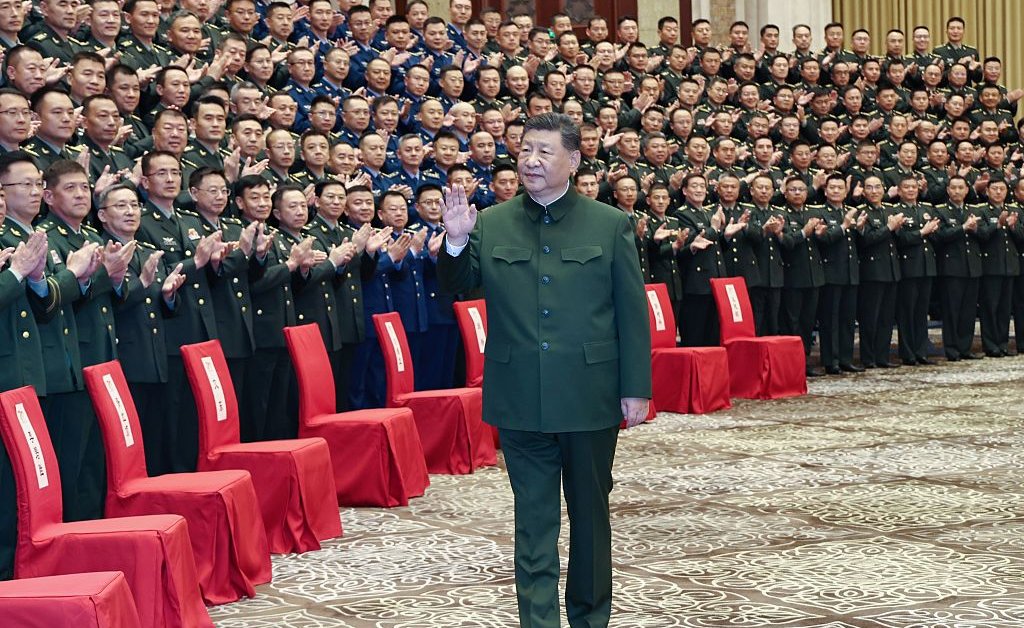In the dark days of 1940, as Nazi Germany consolidated its grip on Europe, President Franklin D. Roosevelt delivered a stark warning to the American people. The nation, he said, could no longer pretend it was safe from the gathering storm. To keep war from spreading to American shores, the nation had to become the “great arsenal of democracy.”
Today, 85 years later, a new storm is gathering in the Western Pacific. A new authoritarian power is conducting the largest military buildup since World War II. While China is not Nazi Germany, it wants to seize hegemonic control over the world’s most dynamic region and reset the global order to advantage its own interests at the expense of the United States.
The most dangerous and likely trigger for a U.S.–China conflict is a Taiwan crisis, but the stakes are about far more than Taiwan. To keep the homeland safe, America needs a strategy to deter a devastating war, preserve its strategic position in Asia, and thereby maintain an honorable peace with China. Achieving this goal must start with a national effort to rebuild our industrial and military might. Deterrence is a system. Industrial capacity is an essential input in that system, as are technology, allied coordination, and strong leadership.
Many Taiwan crisis scenarios can be imagined. They range from a formal blockade with warships, to a “quarantine” with coast guard ships, to a smaller attack on Taiwan’s outlying islands, to a full-scale invasion and war with the United States. China may pursue any of these strategies in combination or in sequence. The United States must prepare for all of them. In blockade and quarantine contingencies, lawfare and economic coercion might matter as much as air-naval power. But if Chinese President Xi Jinping uses brinkmanship to test U.S. and Taiwanese resolve, clever diplomatic strategies and economic threats will not be effective substitutes for robust military deterrence.
Beijing would obviously prefer to take Taiwan and seize global supremacy without a war with the United States, but Xi is also openly preparing to fight such a war. “We must adhere to bottom-line thinking and worst case scenario thinking ,” Xi told the National Security Commission in a May 2023 meeting. China’s ship of state must be ready to withstand “high winds, choppy waters, and even dangerous storms.” According to former CIA Director William Burns, Xi has ordered the People’s Liberation Army (PLA) to be ready to forcibly seize Taiwan by 2027. More broadly, China is preparing for a prolonged general war by stockpiling the raw materials and components it would need to fight and win.
Deterring a conflict with China is the safest, cheapest, and most sustainable way to ensure security and stability in the Western Hemisphere. It must therefore be the United States’ top strategic priority. In 1950, General Douglas MacArthur observed that the First Island Chain—an archipelago stretching from Japan down to Southeast Asia—would play a crucial role in such a strategy. Taiwan is a key link in this chain; MacArthur called it an “unsinkable aircraft carrier.” If Taiwan falls under China’s control, the PLA will find it far easiesr to project military power around Japan, the Philippines, the South China Sea, and into the broader Western Pacific. From this favorable position, it would eventually project air and naval power across the Pacific to threaten the American homeland—just as Japan did in 1941.
If Taiwan were to fall, the U.S.’s ability to defend regional allies such as Japan and the Philippines from future attacks would be severely compromised, degrading the credibility of U.S. security assurances. Smaller countries in the region, especially in Southeast Asia, would have to submit to Beijing’s dictates. Decision makers in Seoul and Tokyo would fear abandonment by the United States, and may move towards developing nuclear weapons programs. This could set off a chain reaction that would be disastrous for U.S. interests globally, including in the Western Hemisphere.
Moreover, economic globalization has made Taiwan important for reasons that MacArthur could not have imagined seventy years ago. A conflict over Taiwan could lead to the destruction of Taiwan’s semiconductor industry, crashing the stock market and costing millions of American jobs. If China seized Taiwan’s chipmaking facilities intact, it might starve the United States and its allies of computation power and seize the commanding heights of AI technology. China would also suffer economically in any conflict, but the American interest should be to deter the conflict from breaking out in the first place and preserve an honorable peace.
If the goal is to persuade Xi Jinping that the costs and risks of provoking war with the United States would exceed any possible benefit, America must show that it could destroy China’s air and naval forces. Taiwan, Japan, Korea, and others must do more to strengthen their own defenses and resilience. But the United States must also organize and equip itself to defeat the PLA directly. If for whatever reason Taiwan falls under the People’s Republic of China’s (PRC) control in the future, it will be all the more important for the United States and its allies to have a dominant conventional force that can deter further Chinese aggression.
It is important not to focus solely on capabilities—the systems, technologies, and operational techniques for achieving U.S. objectives in specific scenarios. The United States also needs industrial capacity—the scale and endurance to sustain large-scale operations over time, deploy sufficient forces across multiple theaters, and maintain readiness for multiple simultaneous conflicts. Democrats and Republicans alike recognize the importance of revitalizing American industrial dynamism. As we pursue policies to achieve this goal, it is important to align them with America’s most urgent national security needs.
Washington needs to break from the status quo. Over the past two decades, China has conducted the largest military buildup since World War II. It is systematically developing a force capable of disrupting U.S. operations in the region, and even striking targets in the Western Hemisphere, backed by a vast defense industrial base. While the newly-renamed Department of War has made progress in responding, it is moving too slowly. Over the next decade, the Pentagon will need to improve coordination with industry in the U.S. and allied countries and enact necessary reforms to spend every dollar effectively.
Preserving deterrence will require more money, but it is not just a question of money. It is, more fundamentally, a matter of political will. The world’s major democracies must work more closely together and share the burden of deterring war with China. This collaboration will require American leadership. It will not happen organically.
In short, what is needed is a clear mandate from the President and Congress for a crash effort to preserve deterrence through industrial revitalization. Establishing this political mandate requires building consensus around the specific capabilities we need to produce to deter and defeat China, and engaging the public in an honest conversation about the trade-offs involved.
As Franklin Roosevelt told the public in his famous “Arsenal of Democracy” fireside chat on December 29, 1940: “Our national policy is not directed toward war. Its sole purpose is to keep war away from our country and away from our people.” To that end, “We must have more ships, more guns, more planes—more of everything. And this can be accomplished only if we discard the notion of ‘business as usual.’”
Excerpted with permission from The Arsenal of Democracy: Technology, Industry, and Deterrence in an Age of Hard Choices.
The post How the U.S. Can Prevent a War With China appeared first on TIME.




